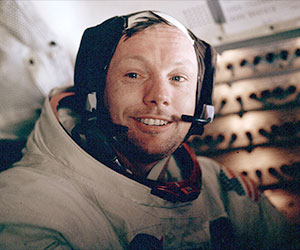 advertisements advertisements
|

|
Photos: Neil Armstrong's Apollo 11 flown-to-the-moon mementos
Feb. 9, 2015 — Neil Armstrong had a secret stash of moon landing mementos.
The first man to walk on the moon kept a bag full of small parts from the lunar module "Eagle" that he and his Apollo 11 crewmate Buzz Aldrin famously piloted to a historic landing at Tranquility Base on July 20, 1969. The stowage bag was discovered by Armstrong's widow after he died in 2012.
"I received an email from Carol Armstrong that she had located in one of Neil's closets a white cloth bag filled with assorted small items that looked like they may have come from a spacecraft," Allan Needell, Apollo artifacts curator at the National Air and Space Museum in Washington, DC, wrote in a blog published on Friday (Feb. 6). "Needless to say, for a curator of a collection of space artifacts, it is hard to imagine anything more exciting."
The story continues here: |
|

|

The photo above (sans numbering) was provided to National Air and Space Museum curator Allan Needell by Carol Armstrong and shows the bag and its contents after their discovery. Numbering was added by the Apollo Lunar Surface Journal. See below for detailed photos of the artifacts, referenced by number. (Credit: Carol Armstrong/ALSJ) |

1. The "McDivitt purse" discovered in Neil Armstrong's closet, as seen during the Apollo 11 mission in Buzz Aldrin's hand as he, Armstrong and Michael Collins flew to the moon in July 1969. (Credit: NASA/ALSJ) |

1. The Apollo 11 temporary stowage bag, above and below, referred to as the "McDivitt purse" after the Apollo 9 astronaut James McDivitt whose idea it was to include it aboard the lunar module. (Credit: Smithsonian) |

1. Apollo 11 temporary stowage bag. (Credit: Ulli Lotzmann/ALSJ) |

2. The orange-colored Data Acquisition Camera (DAC) electrical cable as seen during the Apollo 11 mission. (Credit: NASA/ALSJ) |

2. Data Acquisition Camera (DAC) power cable and its connector. (Credit: Smithsonian) |

3. Apollo 11 training photo showing Armstrong in a lunar module simulator. One of the utility lights is above him. (Credit: NASA/ALSJ) |

3. Utility light with power cable. (Credit: Smithsonian) |

4. Utility light with power cable. (Credit: Smithsonian) |

5. Utility Bracket Assembly (also known as a Utility Clamp). (Credit: Carol Armstrong/Smithsonian) |

6. Utility Bracket Assembly (also known as a Utility Clamp). (Credit: Smithsonian) |

7. Apollo 11 mission photo showing the Crewman Optical Alignment Sight (COAS) installed above Armstrong's window onboard the lunar module Eagle. The COAS was used by Armstrong for rendezvous, docking, star sightings, and horizon alignment. (Credit: NASA/ALSJ) |

7. Crewman Optical Alignment Sight (COAS). (Credit: Ulli Lotzmann/ALSJ) |

8. Crewman Optical Alignment Sight (COAS) filter with casing. (Credit: Smithsonian) |

9. Crewman Optical Alignment Sight (COAS) spare light bulb assembly. (Credit: Ulli Lotzmann/ALSJ) |

10. This waist tether was designed to be used in the case of an emergency spacewalk. Armstrong used it to suspend his legs while trying to rest inside the lander (a determination that the ALSJ team made by inspecting the rediscovered artifact). (Credit: Smithsonian) |

11. Helmet tie-down straps. (Credit: Smithsonian) |

12. The 16mm Data Acquisition Camera (DAC) was used to record the now iconic footage of Armstrong's descent down the ladder to take his "small step" onto the moon. (Credit: NASA/Smithsonian) |

12 (12a and 12b). The Data Acquisition Camera (DAC) was mounted on brackets at either of two locations for views through Buzz Aldrin's window of the final approach to landing, Armstrong's climb down the ladder, moonwalk (EVA) activities in the camera field-of-view, and the ascent from the lunar surface. (Credit: Smithsonian) |

13. Lens shade (Teflon) for Data Acquisition Camera DAC 10-mm lens. (Credit: Ulli Lotzmann/ALSJ) |

14. Alignment Optical Telescope (AOT) eyeguard assembly. (Credit: Ulli Lotzmann/ALSJ) |

15. The mirror was positioned to give Armstrong a view of the Crewman Optical Alignment Sight (COAS) when the latter was mounted in the rendezvous window during approach and docking. Without the mirror, he'd have had to lean a long way back. (Credit: Lotzmann/ALSJ) |

15. Mirror (front). (Credit: Smithsonian) |

16. Tool B (emergency wrench) was a modified Allen-head L-wrench. The wrench was onboard for contingency use with the docking probe and drogue, and for opening the command module's hatch from the outside. (Credit: Smithsonian) |

17. Cover to the waste management (urine-collection) system. (Credit: Ulli Lotzmann/ALSJ) |

18. This netting was mounted vertically next to Buzz Aldrin's flight station to protect pipes, conduits and other gear. (Credit: Smithsonian)
For more information and photographs of the artifacts, see the Apollo Lunar Surface Journal. |
|

© 1999-2025 collectSPACE. All rights reserved.
|
|

|

|
